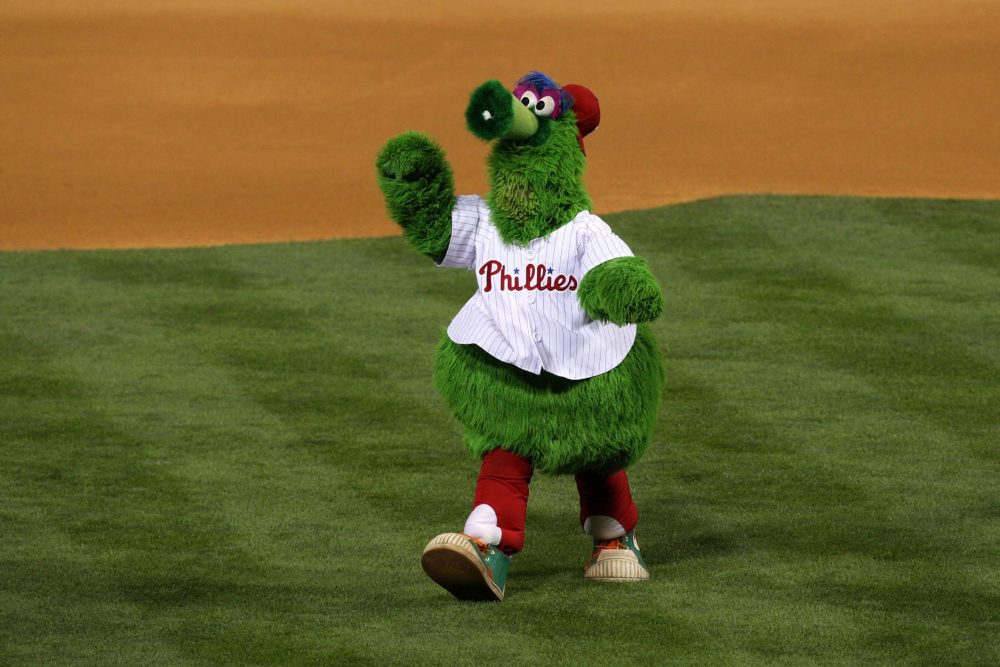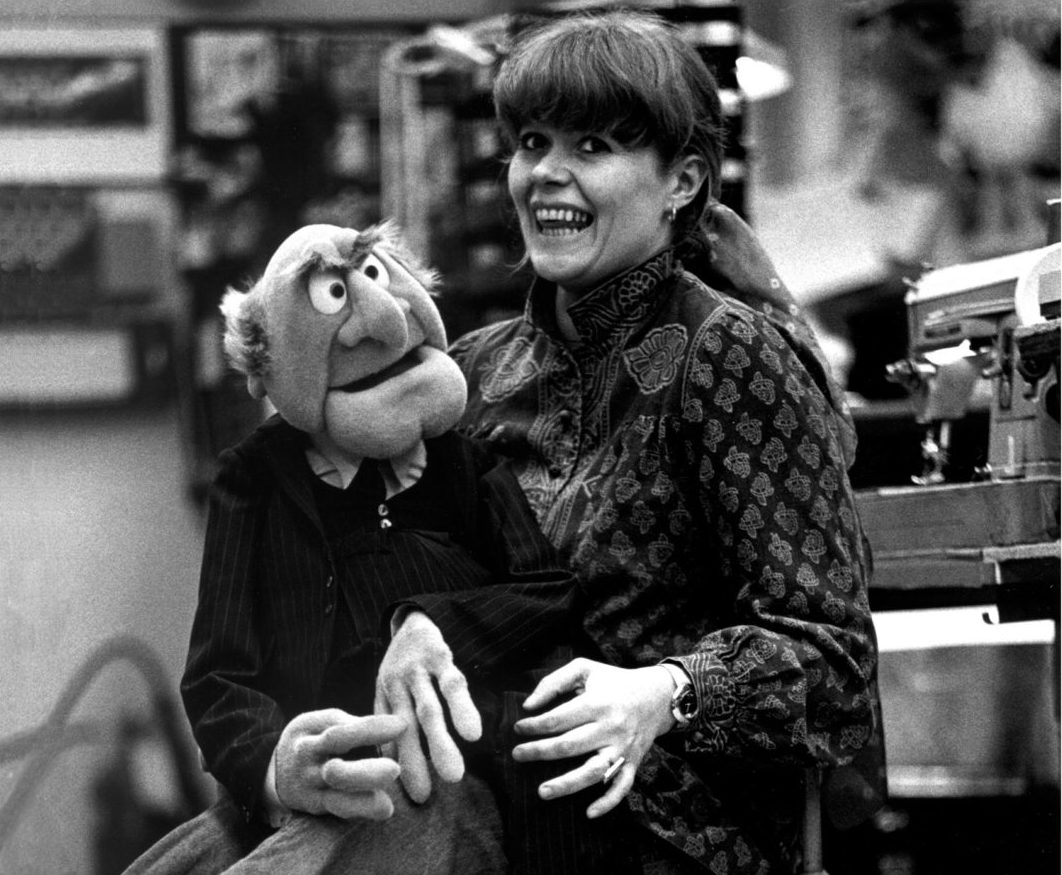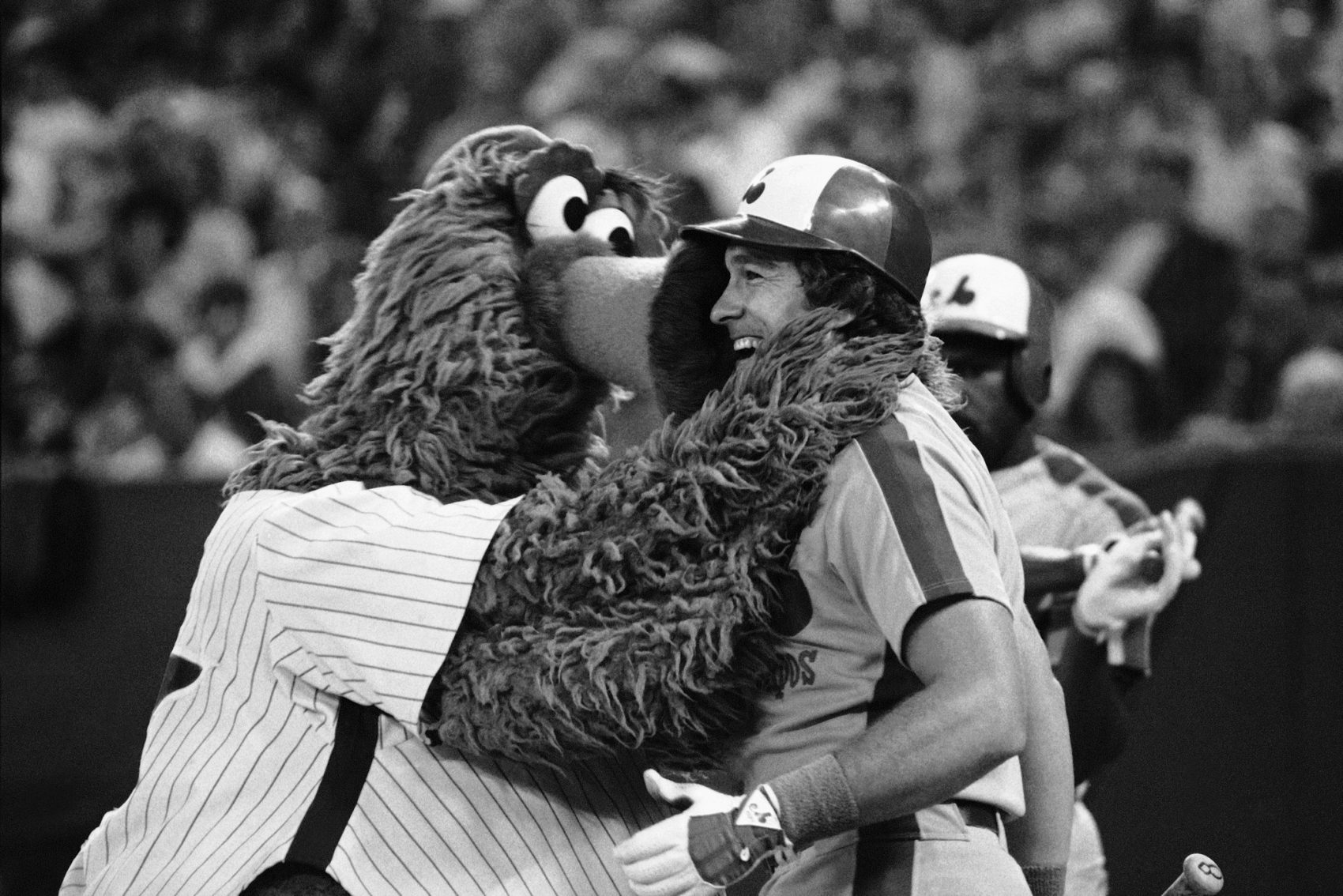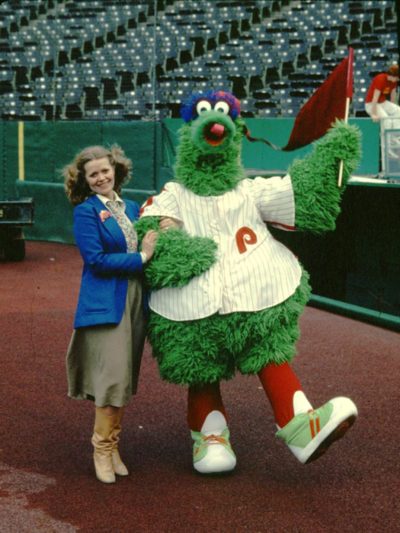Advertisement
From Muppets To MLB: Bonnie Erickson, The Phillie Phanatic ... And Dandy

Bonnie Erickson grew up in Minnesota with dreams of working on Broadway. So, after finishing college, she moved to New York City.
"I worked in costuming for about seven and a half years, always wanting to be a designer," Bonnie says.
But life took her in an unexpected direction.
"I got involved with puppetry, really, through Jim Henson," Bonnie says. "I heard from a friend that he was looking for a costume designer for one of his projects — doing the costumes for ‘Frog Prince.’ "
It was 1970, and Jim Henson was also working on a new TV show called "Sesame Street." As his studio got more work, he needed more staff.
"Jim asked if I would stay on and run the shop," Bonnie says.
Bonnie ended up running the shop for seven years, keeping projects on deadline and making sure everyone had the supplies they needed. But also ...
"I learned how to make puppets during that time," Bonnie says.
Bonnie also learned how to develop her puppets as fully formed characters — as personalities with a backstory. You probably know her work.
Miss Piggy? Bonnie designed her. And Waldorf and Statler, the two old hecklers in the balcony? Bonnie made them, too.
But, although she was enjoying great success in Henson’s workshop, it wasn’t enough.
"Jim knew that I had always wanted to have a business of my own," Bonnie says. "He said, ‘We just won't lose touch.’ And, surprisingly enough, we didn’t. He became one of our first clients."
At first, Bonnie and her husband, Wayde Harrison, worked out of their apartment in Brooklyn and then from a studio in Fifth Avenue in Manhattan. They made lots of puppets for TV commercials. And in 1978, they got a new kind of assignment.
Advertisement
A New Gig
It started when the Philadelphia Phillies approached Jim Henson and asked if he could design a new team mascot.
"And Jim said, ‘No, I'm not doing that kind of thing, but Bonnie Erickson is the person you should talk to,’ " Bonnie remembers. "So, Jim, thank you. We started meetings with the Phillies."
Bonnie says at the time her relationship to sports was "pretty minimal."

The Phillies already had two mascots — a brother and sister pair named Phil and Phillis.
"They were colonial figures that were really not very performable," Bonnie says.
The costumes had huge, cumbersome heads — and that made it hard to be active.
"I think I wanted to make a shape that was going to have its own sort of character," Bonnie says. "So that if you put a performer or a human being in it, it was going to be funny just because of the way it moved."
'It's A Fantasy Animal'
And so Bonnie started creating a brand-new team mascot. She got inspiration from the Phillies' marketing department.
"They had a slogan which was ‘Philly, Be a Phillie Phanatic,’ " Bonnie says. "I took that as wanting to have a megaphone. So that's where the snout for the Phanatic came from."
The Phanatic was green, large, pear-shaped and wore a Phillies jersey.
"And on the back, we wanted to give him a sort of logo of his own, so we gave him a five-pointed star," Bonnie says.
As she had done at Jim Henson's studio, Bonnie created a whole personality, complete with his own biography.
"He evolved in the Galapagos and became this enormous baseball fan," Bonnie explains. "Because, we figured, who could contest that? This seemed to be the perfect background for a character that nobody could describe. It's a purely fantasy animal."
The Big Day
Finally, on April 25, 1978, the Phanatic was ready for his debut.
"Yes, it was a beautiful day — it was a sunny day," Bonnie recalls. "I have no idea whether the team won or not. I hope they did."
For the record, the Phillies beat the Cubs 7–0.
"Everybody decided to just let him appear, not to make any big announcement," Bonnie says. "These were the Phillies' fans — you weren't gonna force them into anything.
"And so he just sort of appeared. He came on the field. The costume looked clean, bright and got a lot of laughs. It’s the laughs you're waiting for. So, all in all, that first day was a big success."
Bonnie says she first remembers realizing that the Phanatic was going to be big when she walked into a store surrounded by the mascot's merchandise — much of it she had designed herself.
"It was enormously satisfying to stand in the middle of all this stuff," Bonnie says.

It was also pretty lucrative. Before the Phanatic debuted, Bonnie and Wayde had offered to sell the copyright to the Phillies for $1,300. The team turned down the offer.
"Once they saw how successful it was and how popular it was, then they chose to buy the copyright from us," Bonnie says. "It cost them more."
(To be precise, $248,700 more.)
The Phanatic quickly became one of the most popular mascots in sports. In 2011, Forbes magazine called it America’s favorite mascot.
However, not all of Bonnie and Wayde’s mascots were such big hits. Not at all.
"Oh, boy. Dandy," Bonnie sighs.
"We were approached by the Yankees — which surprised me, because even though I'm not a big sports fan, I knew that they were pretty traditional," Bonnie says. "I was excited about the fact that the Yankees, our hometown team, was interested in having a mascot. And my thinking at the time was to do something very traditional."
Like the Phanatic, Dandy was large and pear-shaped.
"He was a dyed-in-the-wool Yankee, which meant that we did fur fabric that alternated white with blue stripes," Bonnie says. "And he had a big hat that spun around on the top of his head, he had a red handlebar mustache and looked very much like a turn-of-the-century kind of baseball player."
Dandy, Bonnie And 'The Boss'
Dandy’s design needed approval from one of the most feared owners in all of sports: George Steinbrenner. Bonnie didn’t know much about him.
"Wayde knew, but he wasn't gonna tell me how intimidating George Steinbrenner could be," Bonnie says.
Wade and Bonnie headed up to Yankee Stadium to meet "The Boss."
"He seemed to like the sketch, but he said that the blue was not dark enough," Bonnie recalls. "And I said, ‘Well, if we're doing product, it shouldn't really be that dark, because it's not going to be that appealing.’
"So, right off the bat, we had an argument going. We did resolve it. We did finally hit on the right color, but I have to say — when I came out of the meeting, the people in George's office who had been sitting in the back part of the room during the conversation said, ‘We don't really think anybody's ever contradicted George.’ "

Dandy was snakebitten from the get-go. On July 10, 1979, weeks before Dandy was to debut, the Yankees played an away game in Seattle. The Mariners were about to host the All-Star Game, and they had hired a mascot associated with another team: the San Diego Chicken.
The Chicken was just a few years older than the Phanatic, and, with its bright, colorful feathers, the mascot had become nationally famous. Kids and fans loved the Chicken. Sadly, Yankees outfielder Lou Piniella did not. While the Chicken was placing a hex on Yankees pitcher Ron Guidry, Pinella chased after it, cursing and ultimately throwing his own glove at it.
"George Steinbrenner was also furious," Bonnie says. "And his comment at that time was, ‘Those things don't belong on the field.’ Well, George, in about two weeks you're going to be introducing your own character, and what does this mean?"
It meant Dandy wouldn’t receive team support. But no one told that to Bonnie and Wayde.
"We came to the introduction of the character — and we sat in George's booth, and we never saw the character at all," Bonnie laughs. "The entire game, we never saw the character. So that was sort of an indication that this was not going to be something they supported or that they were going to promote."
It got worse. Not long after Dandy’s introduction, Yankees captain and beloved icon Thurman Munson died in a plane crash.
"Since we had introduced the character around the same time, there was a confusion about whether this character was inspired by him," Bonnie says.
The problem was, Dandy did kind of resemble Munson.
"He had that same kind of turn-of-the-century look with the handlebar mustache," Bonnie says. "And often it's been mistakenly thought that I was trying to do a Thurman Munson character."
Dandy was relegated to the stands and left to fend for himself.
"In the upper decks, it could be pretty volatile sometimes, so we were concerned for the safety of the character," Bonnie says. "I think they didn't want to provide someone to accompany the performer, which we thought was paramount."
After several years, Dandy’s contract expired.
"We decided not to renew, and I think they were just as happy not to as well," Bonnie says. "It was disappointing to find that the character didn't take off the way we had hoped it would — but, you know, everybody fails. You don't hit it every time."
Bonnie Erickson and her husband Wayde continued to design some of the most recognizable mascots in sports, including the Montreal Expos’ beloved Youppi, the Kansas City Chiefs’ KC Wolf and several others.
This segment aired on July 13, 2019.
